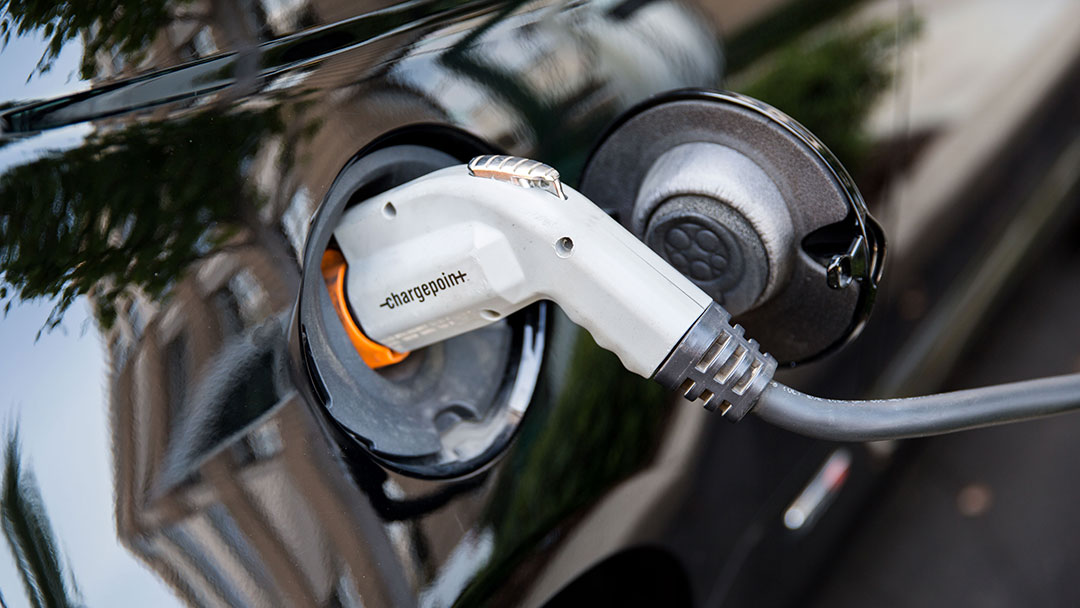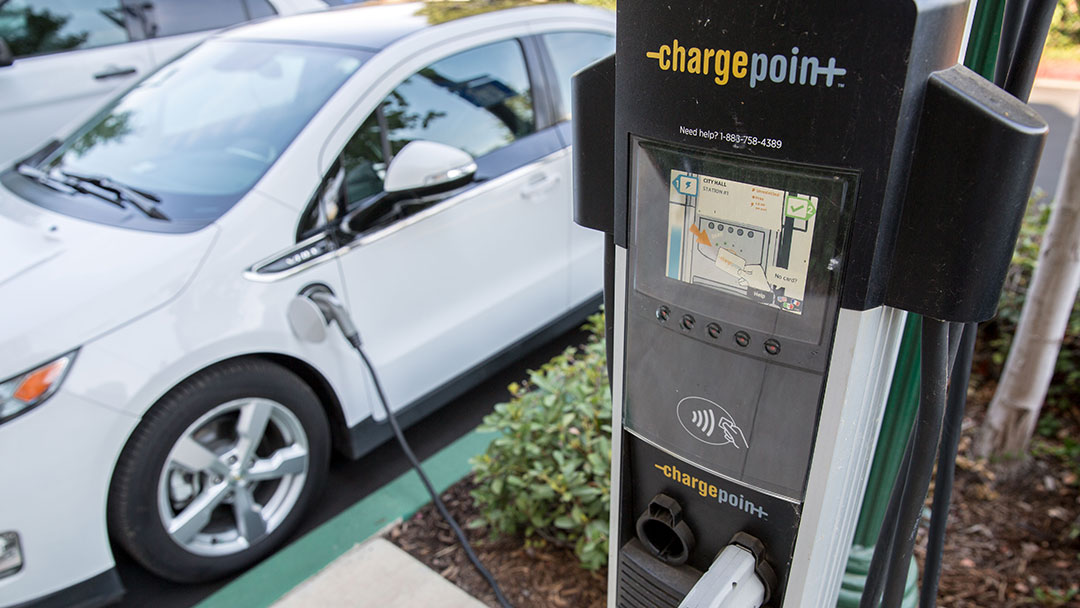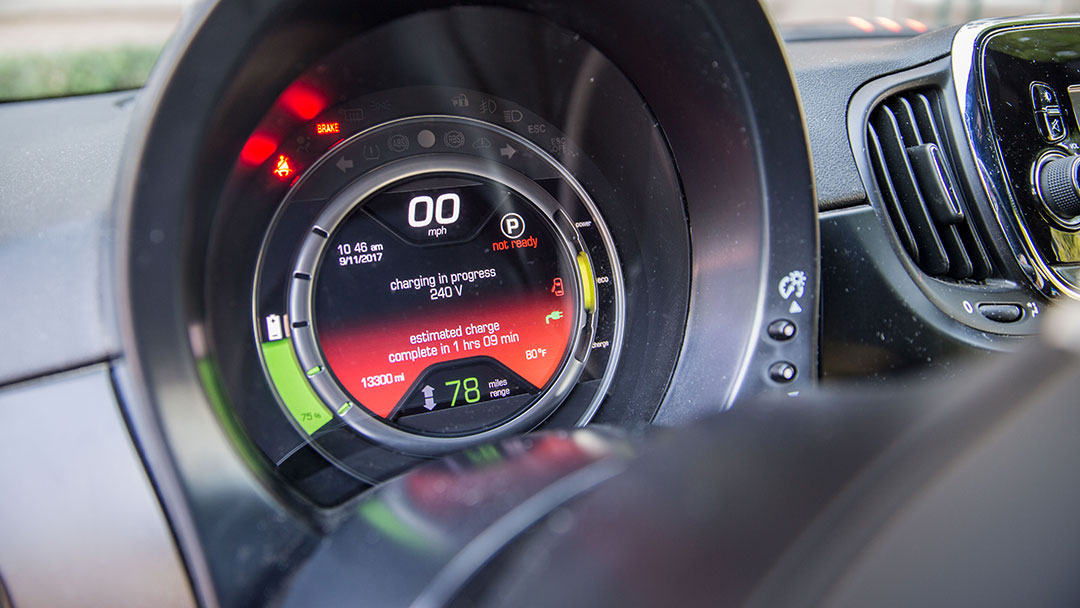California Drives Toward Electric Future
California has ambitious plans for zero-emissions vehicles. UC Davis experts weigh in on reaching those goals.
The pressure is on for California to meet its clean-vehicle goals. In less than two years, 35% of vehicles sold must have zero tailpipe emissions. And by 2035, all light-duty vehicles sold must be zero emissions.
Automakers have ramped up their production of battery electric and plug-in hybrid vehicles to meet this mandate, and so far, sales seem to be on track. But many questions remain on how to achieve this wholesale revamping of transportation. Experts at UC Davis are researching how to overcome the remaining road bumps to eliminating tailpipe emissions. Here, they answer some common questions on California’s zero-emissions mandates.

Downtown Los Angeles, seen in 2005.
Photo by David Iliff. License: CC BY-SA 3.0
Where did the California mandate come from?
While the zero-emissions target may have felt sudden to some when Gov. Gavin Newson announced it in an executive order in 2020, it’s really the next milestone on a road that state officials have been pursuing since the 1990s.
California first began to introduce regulation in the early 1990s, explained Alan Jenn, an assistant professor in the UC Davis Department of Civil and Environmental Engineering and researcher at the UC Davis Institute of Transportation Studies. At the time, unhealthy air plagued regions such as the Los Angeles metropolitan area and inland valleys — frequently, cities failed to meet federal and state thresholds for pollutants. So, officials started setting targets for automakers to offer zero-emissions vehicles among their fleets. But, as automakers stalled in the rollout of clean cars, regulations were delayed.
Finally, when in the 2000s automakers began rolling out viable hybrid and electric vehicles, the state air resources board started putting formal targets in place. The governor’s executive order was really the next step to ensure continued progress along this route, said Jenn. In 2022, the air resources board formalized the executive order, making it official that all light-duty vehicles — including passenger cars, trucks and SUVs — sold in the state must be zero emissions by 2035.
Are we making enough progress to achieve the mandate?
Aside from a couple of flat years of sales between 2018 and 2020, sales on electric vehicles in California have been rising since 2011. Today, one in four new cars sold in the state is an EV, said Dahlia Garas, program director at UC Davis’ Electric Vehicle Research Center.
As batteries become cheaper, ranges increase and competition increases between automakers, electric vehicles are growing more affordable and attractive to drivers. “We’re making reasonably good progress,” said Garas. “I think our market is actually really strong.”
Still, recent news headlines have called attention to the fact that sales in 2023 slowed down. To be clear, more EVs still sold in 2023 than 2022 — but the rate of increase dipped. During the 2019 dip, there were also worries that EVs had reached a market saturation point, but the slowdown turned out to be temporary, said Jenn. He said he remains optimistic. “It’s hard to make those conclusions from these small blips in the data,” he said.

Photo courtesy California Energy Commission
Will the electric grid be able to support that many EVs?
To achieve the zero-emissions vehicle mandate, California will need about 15 times as many electric cars on the road as today. From an energy supply standpoint, state officials believe the state will have a capacity to keep all these cars charged with planned expansion of wind and solar power.
That said, the rollout of electric vehicles may strain the grid, especially if they are all charging at the same time, such as in the evening when people get home from work. In addition to needing a lot of electricity available at those times, that demand could exceed the capacity of local infrastructure, including neighborhood transformers. Utilities will need to upgrade much of this local equipment.
Luckily, encouraging people to spread out their charging times could help with the above issues, said Jenn. For instance, if more people have the option to charge during the day — for example using a charger at their workplace — that would shift demand away from peak evening hours. Incentivizing daytime charging also has the added benefit of drawing power when the sun is out, supplying vehicles with clean and plentiful solar.
Will EVs be affordable for everyone?
If you’re noticing a conspicuous number of luxury EVs, your eyes are not deceiving you. “The lineup of vehicles that most automakers are releasing these days, as it relates to electric vehicles, is more on the top end,” said Jenn. “So there aren’t as many affordable electric vehicles.”
Part of the reason for that is that automakers are attempting to recoup the costs of transitioning their production. Trucks and SUVs have a higher profit margin than smaller vehicles, so companies make more money for each automobile sold.
That said, EV prices are becoming more competitive. They currently are not far off the average price tag for a combustion-powered car. According to Kelley Blue Book, the average price for a new EV was $55,353 in January 2024, whereas the overall average new car price was $47,401. With incentives such as federal tax rebates applied, the cost of an EV shrinks even closer to combustion vehicles.
Still, there is a dearth of affordable options, such as economy sedans that will fill the niche occupied by cars like the Honda Civic or Toyota Camry. Jenn said he expected that automakers will start to fill in these holes over time, making more affordable options available.
Buying used EVs might be a viable affordable option, too. Considerations like battery warranties can help reassure car buyers, about 70% of whom exclusively purchase used vehicles, said Jenn. By 2026, California will require that all EVs come with an eight year, 100,000-mile battery warranty, with the goal of ensuring that used EVs retain most of their battery function.

Photo courtesy California Energy Commission
What if I can’t charge my car at home?
In order for California to be successful, electric vehicles must be practical for everyone — not only for people who can install a garage charger.
Right now, apartment dwellers and renters often don’t have access to a charger at home.
Even when there is a charger around, EV owners in these homes face hurdles. Garas said that she’s heard of charger rates at apartments abruptly shooting up — an unexpected expense that can be especially challenging on an already-tight budget.
Relying on public chargers isn’t a great alternative, either. A public EV charger tends to cost more than home charging, which means renters would potentially have to pay more to charge than homeowners. “Folks that are in apartments, that are maybe lower income than folks that are in single family homes, are now also getting the most expensive charging solution,” said Garas.
To solve these problems, researchers and policymakers will need to consider the needs of people across the car-buyer market. There are federal and state incentives available for installing chargers in multifamily housing, and new developments are required to include chargers. It’s often not as simple as hiring an electrician, however, because EV owners will use more power and charger operators need to recoup those costs. For example, one system to account for energy use is differential parking rates. At UC Davis, drivers who park in a space with a charger pay a higher per-day rate, accounting for the cost of electricity. It may be a straightforward system to apply in other settings, too.
In the meantime, another option for people in multifamily housing or rural areas with limited charging access are plug-in hybrid vehicles. These vehicles can run solely on battery power, like EVs, but can also be powered with gasoline when their charge runs out.
Will I be able to drive long distances?
Not only will people need to be able to charge in their daily routine, but having access to chargers to support longer trips is crucial, too. It’s estimated that by 2035, California will need more than an additional 2 million chargers to support the electric car transition. According to the air resource board, the number of DC Fast chargers, which can recharge a vehicle battery in about 30 minutes, is growing to meet this demand.
But the number of chargers alone won’t be enough to make drivers confident. Every time Jenn gives a talk, he said he asks EV drivers in the audience to raise their hand if they’ve never had a problem using a public charger. No one’s hand goes up.
That problem is motivating UC Davis researchers to study the issues surrounding public charging. Sometimes, a charger may be running just fine, but a driver won’t be able to use it because their cell phone network isn’t supported in that area. To understand bugs like this, a group of UC Davis undergraduates are currently traveling around the state — in an EV, of course — and plugging into more than 3,000 public chargers.

Photo courtesy California Energy Commission
Are EVs actually cleaner? Will the transition make a difference?
Electric vehicles are actually more resource-intensive to build than combustion cars. That’s because their big batteries contain minerals that are polluting and energy-intensive to extract. But that’s only one part of their total footprint.
To get a full picture, you also have to consider impacts over the course of driving the car for several years. Because electric vehicles produce no tailpipe emissions, over time, their carbon footprint relative to combustion vehicles goes down. Additionally, as electricity in California is increasingly generated with renewable sources, the energy that is powering EV motors will also be cleaner. Even right now, when accounting for the pollution from power plants, a combustion car would need to hit 134 miles per gallon in order to be cleaner than an EV. “When you actually run the numbers,” said Jenn, “The EVs tend to be quite a bit better over the full lifecycle.”
Meeting the mandate would be huge for the state’s emissions, almost 40% of which come from tailpipes. “It’s just such a huge percent of our emissions,” said Garas. “Tackling and cleaning our transportation systems in any way possible is going to have an enormous impact on climate and greenhouse gas emissions.”
California’s environmental laws also tend to nudge other states and the federal government along. The recent zero emissions rule is no exception: 13 other states have adopted at least some portion of the mandate, putting the country even closer to slashing climate-warming transportation emissions.




